|
MTX Plus+
CP/M
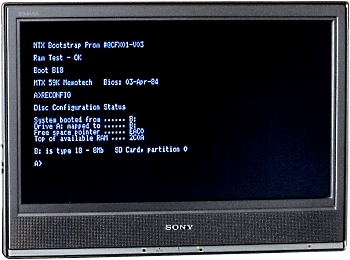
I had originally thought that getting
CP/M running on
MTXPlus+ would mean writing a custom BIOS from scratch (see
below).
However, Martin has been busy again and ported Andy Key's
REMEMOrizer ROM code to MTXPlus+. The screenshot shows
MTXPlus+ booting CP/M from a Compact Flash card which contains a
copy of Andy's CP/M system disk included with REMEMOrizer.
At this point, the software is unfinished - for example, the
system does not currently support Memotech FDX/SDX colour
attributes, but Martin has made a great start. The system can run
CP/M transient programs such as "PIP" and "STAT", third party
programs such as CRCK44 as well as Memotech utilities such as
MTX/MTXL which switches the system into 40 column MTX BASIC
mode. The photos below are a selection of the screen displays
from Martin's TV - the images give a flavour for how the display
looks, but do not do justice to the video output - the quality
is much better in reality.
|
The
output from "STAT DSK:", showing the
structure of the disk (CF card partition) as seen by
CP/M - copied from REMEMOrizer :
65472
x 128 byte Records, i.e., 8MBytes
512
Directory entries
2
Reserved tracks (for CP/M)
|
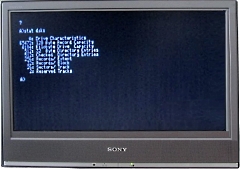 |
| With its 512KB of RAM, MTXPlus+ also supports a
Type 52 RAM disk like REMEMOrizer.
This screenshot shows the system running the
RAMDISC submit file from REMEOrizer. Drive "F" has
been created as a 320KB RAM disk and a number of
CP/M tools have been copied to it, allowing them to
run from RAM. |
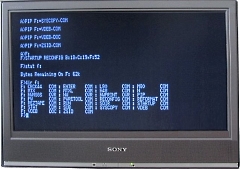 |
| Screen shot of the system running NewWord with
VDEB.DOC open for editing. |
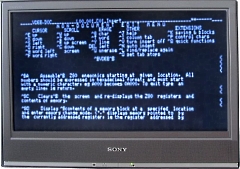 |
| Martin has been busy again . . . . .
NewWord now running in colour - the attribute
code is still not finished, but this is a big step
forward. |
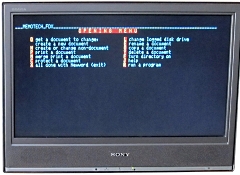 |
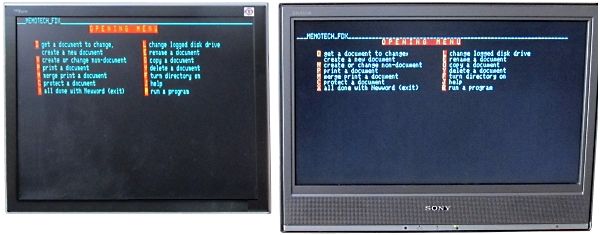 |
|
Display Comparison |
|
REMEMOrizer |
| VGA Output |
| Aspect Ratio 4:3 |
|
|
MTXPlus+ |
| NTSC RGB Output |
| Aspect Ratio 16:9 |
|
Original Concept
My ultimate aim is to get CP/M running on MTXPlus+
to enable me to run some of the large range of software that is
available for CP/M. Initially, I will be using CP/M 2.2 - the
same version as used by the original Memotech FDX and SDX, as
well as the BBC Micro, but may ultimately try to migrate to CP/M
3 which supports memory paging, subdirectories and file
date/timestamps.
My Memotech MTX focused
CP/M pages provide a high level overview of CP/M, but the
key principle is that CP/M was written to be transportable,
different systems can run the same software programs with only a
limited quantity of machine specific programming at Operating
System level. All CP/M
systems have their own Customised Basic I/O System (CBIOS, or
just BIOS), used to interface the machine specific hardware with
the high level CP/M function calls for such items as the
keyboard, video display and disk drives.
This page is a repository for useful information that may be
used while developing the MTXPlus+ CP/M BIOS. A
number of Digital Research documentation for CP/M 2.2, including
the
CP/M 2.2 System Alteration Guide can be found on my
CP/M manuals page.
|
Resources |
| Title |
Source |
Description |
|
nzmon.mac
 |
oldcpusrus |
Hack of an old S.D.Systems monitor
program, updated to include bank switching logic, a
.hex file download, and a far more extensive floppy
disk interface that the original. It uses the Zilog
SIO/2 serial chip for the system console. |
|
cbios.mac
 |
A preliminary CBIOS written for a
Z80 prototype being built by Roger Hanscom of
oldcpusrus |
|
block.prn
 |
Original block/deblock code from
Digital Research |
|
bios.mac
 |
oldcpusrus |
A generic BIOS from "The
Programmer's CP/M Handbook" by Andy Johnson-Laird |
|
cpm2-htm.zip
 |
The
Unofficial
CP/M
Website |
Digital Research CP/M 2.2 Operating
Manual in html format, including a chapter on
CP/M Alteration and an example
"bare bones" BIOS. |
| |
|
|
| |
|
|
| |
|
|
|